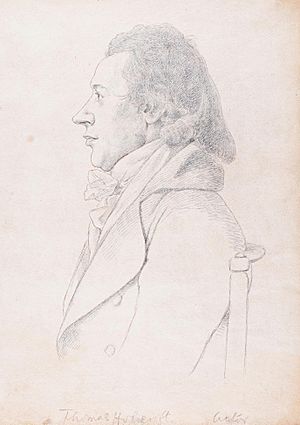Thomas Holcroft facts for kids
Quick facts for kids
Thomas Holcroft
|
|
|---|---|

Portrait, oil on canvas, of Thomas Holcroft (1745–1809) by John Opie (1761–1807)
|
|
| Born | 10 December 1745 Orange Court, Leicester Fields, London
|
| Died | 23 March 1809 (aged 63) |
| Occupation | Dramatist |
| Years active | 1778-1802 |
Thomas Holcroft (born December 10, 1745, died March 23, 1809) was an English writer. He wrote plays, poems, and other works. He also translated books from other languages.
Thomas Holcroft supported the early ideas of the French Revolution. He even helped his friend Thomas Paine publish a famous book called The Rights of Man.
Contents
Early Life and First Steps
Thomas Holcroft was born in London, in an area called Orange Court near Leicester Fields. His father was a shoemaker and also rented out horses. However, his family faced tough times. They ended up selling goods as pedlars, traveling from place to place.
Young Thomas went with his parents on these journeys. He later found a job working with horses at Newmarket. This was at the stables of Hon. Richard Vernon. In the evenings, he spent his time reading many different books. He also studied music. Over time, he taught himself French, German, and Italian.
From Stables to Stage
When his job at the stables ended, Thomas went back to London. He helped his father, who had started making shoes again. Around 1765, Thomas became a teacher at a small school in Liverpool.
He tried to open his own private school, but it didn't work out. Instead, he became a prompter at a theatre in Dublin. A prompter helps actors remember their lines. He then worked as an actor in different traveling theatre groups.
In 1778, he wrote his first play, The Crisis; or, Love and Famine. It was performed at Drury Lane theatre. Another play, Duplicity, followed in 1781.
Writing and Political Ideas
Two years later, Holcroft went to Paris. He worked there as a reporter for the Morning Herald newspaper. While in Paris, he often watched performances of Beaumarchais's play Mariage de Figaro. He watched it so many times that he memorized the whole play!
He then translated it into English. His version was called The Follies of the Day. It was performed at Drury Lane in 1784. His comedy The Road to Ruin was his most successful play. It was first performed in 1792. When it was brought back to the stage in 1873, it ran for 118 nights.
Novels and Translations
Holcroft also wrote several novels. His novel Alwyn (1780) tells the story of a traveling actor. It was based a lot on his own life. Anna St. Ives (1792) was one of the first British novels to support the ideas of the French Revolution. He also wrote The Adventures of Hugh Trevor (1794–1797).
He wrote a travel book called Travels from Hamburg through Westphalia, Holland and the Netherlands to Paris. He also wrote some poetry. Thomas Holcroft translated many books from French and German. One of these was Letters Between Frederic II and M. De Voltaire (1789).
Supporting Change
Thomas Holcroft believed in the early ideas of the French Revolution. In 1791, he helped publish the first part of Thomas Paine's important book, The Rights of Man.
In 1792, he joined a group called the Society for Constitutional Information (SCI). This group wanted to make changes to the government. Because of his active role, Holcroft faced some difficulties in 1794. He was held in Newgate Prison while other trials took place. However, he was released without a trial in December 1794. This happened after other people, like Thomas Hardy and John Horne Tooke, were found not guilty in their trials.
After this, it was harder for Holcroft's plays to be successful. Even so, he helped bring a new type of play called melodrama to Britain. His plays Deaf and Dumb (1801) and A Tale of Mystery (1802) were examples of this. A Tale of Mystery was a translation of a French play.
Thomas Holcroft passed away in 1809. Before he died, he became friends again with William Godwin, who had been his closest friend. After his death, his life story, Memoirs written by Himself, was published in 1816.
Family Life
Thomas Holcroft was married four times during his life.
His first wife's name is not known, but they married around 1765. They had a daughter named Ann (1766–1841). Ann later married Colonel William Tooke Harwood.
In 1772, Holcroft married Matilda Tipler. They had two children: a son named William (1773–1789) and a daughter named Sophia (1775–1850). Sophia later married William Cole, a merchant. After Cole's death, she married Georges Nicholas Mergez, a general in the French army.
After his second wife passed away, Holcroft married Diana Robinson in 1778. Diana died in 1780 after giving birth to their daughter, Fanny Margaretta (1780–1844). Fanny Holcroft became a writer herself. She wrote a poem about anti-slavery called "The Negro" (1797). She also wrote novels like Fortitude and Frailty and The Wife and the Lover. Fanny also translated plays for her father's publication.
Nine years later, in 1799, Holcroft married his fourth wife, Louisa Mercier (1779–1853). She was the daughter of a family friend. They had four sons and two daughters. Their daughter Louisa (1801–1869) later married John Badams and then Barham Cole Mergez. Their son Thomas Holcroft Jr. (1803–1852) became a journalist. After Thomas Holcroft's death, his wife Louisa remarried James Kenney, who was also a playwright.
Selected Plays
- Duplicity (1781)
- The German Hotel (1790)
- The School for Arrogance (1791)
- The Road to Ruin (1792)
- Love's Frailties (1794)
- The Deserted Daughter (1795)
- The Force of Ridicule (1796)
- The Man of Ten Thousand (1796)
- He's Much to Blame (1798)
- Knave or Not? (1798)
- Hear Both Sides (1803)
- The Vindictive Man (1806)


